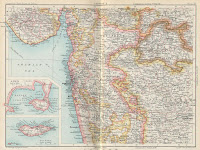There is no controversy whatsoever! The Azad Hind Fauj under Netaji Subhas Chandra Bose successfully entered India and Colonel Shaukat Malik, who hailed from Multan in western India in the province of Panjab and the local Manipuri supporters of the Indian National Army under Shri Mairembam Koireng Singh hoisted the Tricolour 🇮🇳 in the liberated part of the mainland of India in Manipur at Moirang on 14, April 1944. Shah Nawaz Khan, a Janjua Rajput from Rawalpindi, Panjab, western India of the Indian National Army led the army into northeastern India, liberating Kohima and Imphal which were held briefly by the INA. Shah Nawaz Khan was profoundly influenced by Subhas Chandra Bose's speeches asking POWs to join the Indian National Army and to fight for a free India. According to Shah Nawaz Khan, "It will not be wrong to say that I was hypnotized by his personality and his speeches. He placed the true picture of India before us and for the first time in my life I saw India, through the eyes of an Indian." Nawaz joined the INA in 1943. He was included in the Cabinet of the Arzi Hukumat-e- Azad Hind (INA) formed by Bose. Another Indian from Panjab who joined the INA was Mohammad Zaman Kiani who was born in the village of Shakarparian in the Rawalpindi District in western India. Previously, In the Islands comprising the Andaman and Nicobar Islands, Sukhadhara, and the Lakshadvipa
archipelago, Netaji had already hoisted the Trivarña 🇮🇳 in Port Blair in the Andaman and Nicobar Islands on 30, December 1943 and proclaimed a free, independent Sovereign India which pee se included the Coco Islands in the northern part of the Andaman and Nicobar Islands which was recognised by around 18 countries. Afterwards, there were fear of large-scale desertion of Indians in the British Indian Army and the English could no longer trust and take for granted the loyalty of the Indian Army and feared widespread mutiny and they were constrained to leave India bag and baggage before being forcibly kicked and thrown out albeit after partitioning the provinces of N.W.Frontier Afghanistan Province and Baluchistan in western India along with the adjoining areas of western Pañjab and Sindh from the rest of India. It was not Mohandas K. Gandhi or the wolf in sheep's clothing who ran with the hare and hunted with the hounds, one Mr. Jawaharlal Nehru who won India her independence, but the Ghadar independence movement and Netaji Subhas Chandra Bose and the Indian National Army!
Amritsar was established as the control centre for the activity of the Ghadar party which had to be changed to Lahore on February 6,1915 due to security considerations. After analyzing all the reports from the organizers amongst the army and civilians, it was decided on February 12,1915 that the date of uprising will be February 21,1915. The plan was to occupy the cantonments of Mian Mir, Ferozepur, Meerut, Lahore, and Delhi and proclaim the Republic of India. Garrisons in Kohat, Bannu and Dinapur were also to revolt on the same day. Kartar Singh Sarabha was to take control of Ferozepur and Pingle to march to Delhi from Meerut with the 128th Battalion.
Dr. Mathura Singh was sent to the frontier areas of the Northwest to organize the Afridis and others. Nidhan Singh Chugha, Gurmukh, Singh and Harnam Singh were sent to Jhelum, Rawalpindi, and Hoti Mardan. Parmanand went to Peshawar. Others were sent to Ambala, Meerut, Lucknow, Allahabad, Benares, Dinapur, and Faizabad to raise the banner of revolt. They also decided that the flag of this revolt and republic would be a tricolor of Red, Green and Yellow with two swords crossing in the centre. The organization of revolt in the eastern part of India, such as in Bengal and Assam, was to be coordinated by the Bengali revolutionaries.
The army of the Ghadarites also defeated the British forces in the province of Sistan in Afghanistan. The Ghadar army chased the British forces into the Karamshir area in the province of Baluchistan in western India. Here they heard the news and declaration of the Free Hindustan by the
Provisional Government of India headed by Mahendra Pratap. From here the Ghadar army advanced towards Karachi and took over the coastal towns of Gawador and Dawar in the Makran Coast east of Chah Bahar in the province of Baluchistan in western India. The Baluch chief of Bampur declared his independence from the British rule and joined the Ghadar forces.
The Provisional Government of India established in Kabul, Afghanistan on December 1, 1915 by Indian Nationalists composed of Mahendra Pratap as President, Maulana Barkatullah as Prime Minister, Deobandi Maulavi Ubaidullah Sindhi as Home Minister, Deobandi Maulavi Bashir as War Minister, and Champakraman Pillai as Foreign Affairs Minister.


No comments:
Post a Comment